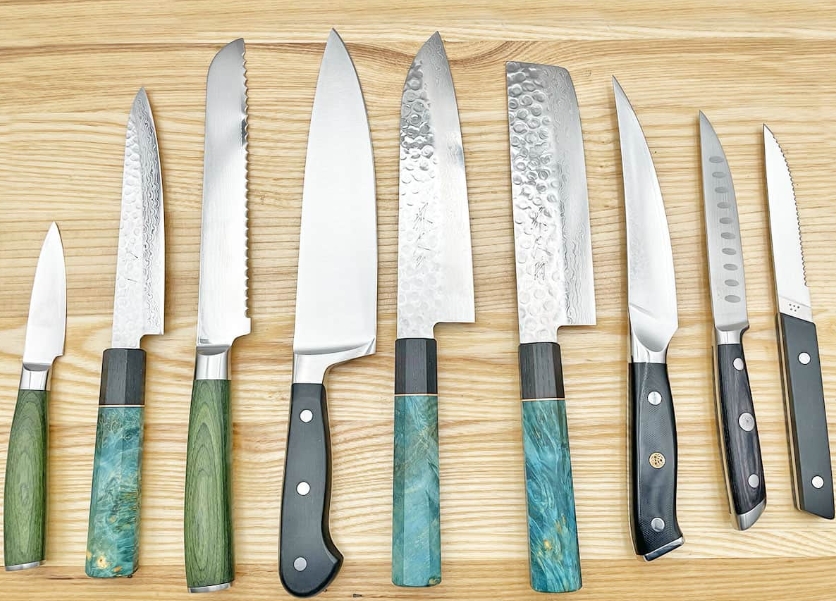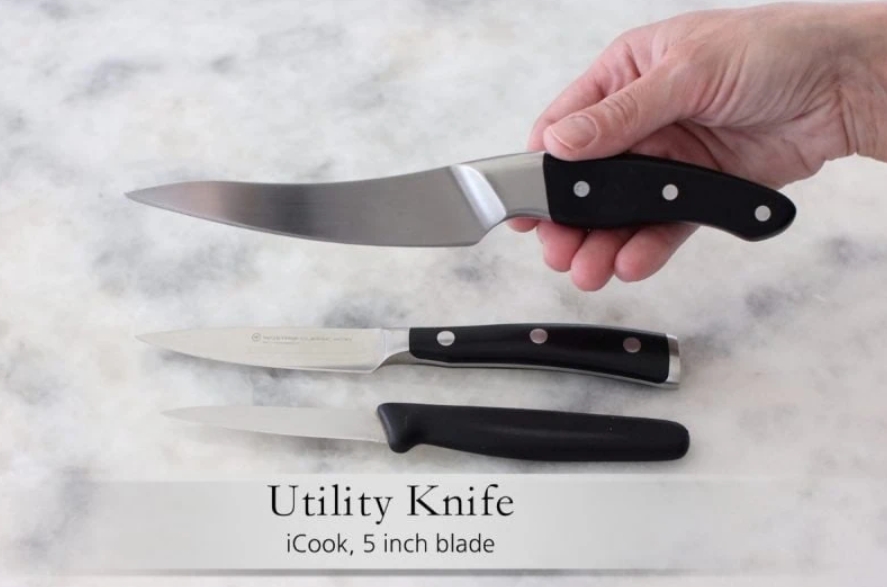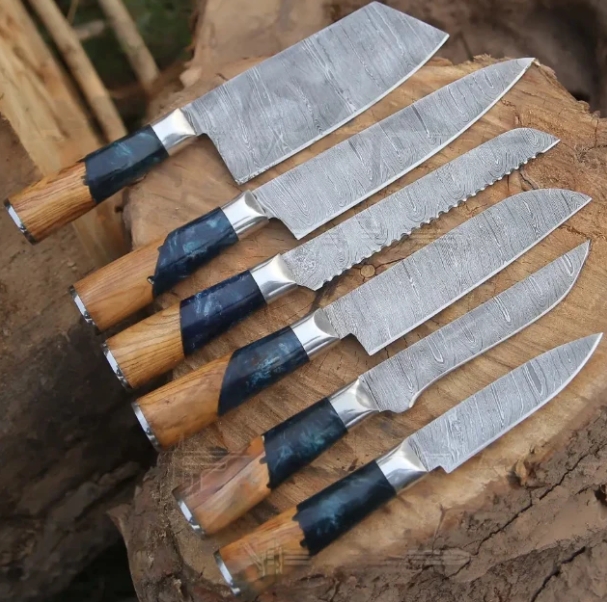

Views: 222 Author: Ella Publish Time: 2025-04-23 Origin: Site








Content Menu
● What Are Forged and Stamped Chef Knives?
● The Manufacturing Process: Forged vs. Stamped
>> Forged Knives: Traditional Craftsmanship
>> Stamped Knives: Modern Efficiency
● Key Features and Differences
● Performance Comparison: Which Knife Excels Where?
>> Forged Knives: Strength and Precision
>> Stamped Knives: Speed and Flexibility
● Pros and Cons of Forged and Stamped Chef Knives
● How to Choose: Which Knife is Right for You?
● Visual Guide: Identifying Forged and Stamped Knives
● Real-World Applications: Professional and Home Kitchens
● Maintenance and Care Tips for Both Knife Types
● The Evolution of Knife-Making: Tradition Meets Technology
● Myths and Misconceptions About Forged and Stamped Knives
>> Myth 1: All Forged Knives Are Superior
>> Myth 2: Stamped Knives Are Only for Amateurs
>> Myth 3: Forged Knives Never Need Sharpening
>> Myth 4: Stamped Knives Are Always Cheap
● FAQ: Top 5 Questions About Forged vs. Stamped Chef Knives
>> 1. Are forged knives always better than stamped knives?
>> 2. How can I tell if my chef knife is forged or stamped?
>> 3. Do stamped knives require more frequent sharpening?
>> 4. Is it worth investing in a forged knife for home cooking?
>> 5. Can I use both forged and stamped knives in my kitchen?
Choosing the right chef knife is a pivotal decision for both professional chefs and home cooks. Among the most debated topics is the difference between forged and stamped chef knives. These two categories not only differ in their manufacturing process but also in their performance, durability, price, and suitability for various kitchen tasks. In this comprehensive guide, we will explore every aspect of forged and stamped chef knives, supported by images, videos, expert insights, and answers to frequently asked questions.

Chef knives are essential kitchen tools, but not all knives are created equal. The terms "forged" and "stamped" refer to how the blade is made, which impacts the knife's weight, balance, durability, and price.
- Forged Knives: Crafted from a single bar of steel, heated, and hammered or pressed into shape. They are typically heavier, feature a bolster, and often have a full tang for balance and strength.
- Stamped Knives: Cut out from a large sheet of steel (like a cookie cutter), then heat-treated and sharpened. These knives are lighter, more flexible, and generally more affordable.
Forged knives are made by heating a steel bar until it glows red-hot, then pounding it into shape using a hammer—either by hand or machine. This process compresses the steel, aligning its grain structure for greater strength and durability. After shaping, the blade is ground, polished, and heat-treated for hardness. The knife is then fitted with a handle, often featuring a full tang (the metal extends through the handle) and a bolster (the thick junction between blade and handle).
Stamped knives are mass-produced by stamping (cutting) blade shapes from a large steel sheet. The blades are then heat-treated, sharpened, and attached to handles. This process is faster, less labor-intensive, and more cost-effective, making stamped knives widely available and affordable.
| Feature | Forged Chef Knife | Stamped Chef Knife |
|---|---|---|
| Manufacturing | Heated and hammered from steel bar | Cut from steel sheet and heat-treated |
| Weight | Heavier, solid feel | Lighter, easier to maneuver |
| Blade Thickness | Thicker, with a pronounced spine | Thinner, more flexible |
| Bolster | Usually present, adds balance/protection | Rarely present |
| Tang | Full or partial tang | Partial or sometimes full tang |
| Edge Retention | Superior, holds edge longer | Good, but dulls faster |
| Durability | More durable, resists bending | Less durable, can bend or break |
| Price | Higher | Lower |
| Maintenance | Requires more care (sharpening, cleaning) | Easier to maintain |
| Best For | Heavy-duty, precise tasks | Light, quick, repetitive cuts |
- Cutting Power: The weight and rigidity make forged knives ideal for chopping dense vegetables, breaking down poultry, or slicing thick cuts of meat.
- Balance and Control: The bolster and full tang offer superior balance, making them safer and more comfortable for long prep sessions.
- Edge Retention: Forged blades maintain sharpness longer due to the steel's density and heat treatment.
- Durability: Less likely to bend or warp under pressure, suitable for professional kitchens.
- Lightweight: Easier to handle for repetitive tasks, such as slicing, dicing, or mincing herbs.
- Flexibility: The thin blade is ideal for delicate work like filleting fish or slicing tomatoes.
- Affordability: Great for beginners, home cooks, or those on a budget.
- Maintenance: Easier to sharpen, though they may require more frequent honing.
Pros:
- Exceptional strength and durability
- Superior edge retention
- Balanced and safe due to bolster and tang
- Ideal for heavy-duty kitchen tasks
Cons:
- Heavier, may cause fatigue over long use
- More expensive
- Requires more skill to maintain
Pros:
- Lightweight and easy to maneuver
- More affordable
- Flexible blade for delicate tasks
- Easier to sharpen and maintain
Cons:
- Less durable, prone to bending or breaking
- Lacks balance and stability of forged knives
- Shorter lifespan, may need frequent replacement
When deciding between forged and stamped chef knives, consider the following:
- Cooking Style: If you frequently tackle tough ingredients or need precision and durability, a forged knife is preferable. For lighter, repetitive tasks, a stamped knife may suffice.
- Budget: Stamped knives are generally more affordable, making them a good entry point for beginners or those on a budget.
- Maintenance: Forged knives require more attention but reward with longevity. Stamped knives are easier to maintain but may need more frequent sharpening.
- Comfort: Try holding both types—choose the one that feels balanced and comfortable in your hand.
Forged Knife:
- Look for a bolster (thick junction between blade and handle)
- Full tang visible along the handle
- Heavier and thicker blade
Stamped Knife:
- No bolster, or a very thin one
- Blade is thinner and lighter
- Handle may not show tang, or only a partial tang

Professional chefs often gravitate toward forged knives for their reliability, balance, and durability. The demands of a busy kitchen require tools that can withstand hours of chopping, slicing, and dicing without losing their edge. Forged knives, with their robust construction, are less likely to fail under pressure, making them a favorite for culinary professionals.
However, many chefs also keep a selection of stamped knives for specialized tasks. For example, a stamped boning knife is ideal for filleting fish due to its flexibility. The lighter weight of stamped knives can also reduce fatigue during repetitive prep work.
Home cooks may find stamped knives more approachable due to their affordability and ease of use. For those just starting to build their kitchen arsenal, a quality stamped chef knife can deliver impressive results without a hefty investment. The lighter weight is especially beneficial for individuals who may not have the wrist strength to wield a heavier forged knife comfortably.
That said, as home cooks become more experienced, many choose to invest in at least one forged knife for tasks that require extra power and precision, such as breaking down larger cuts of meat or chopping root vegetables.
Proper care extends the life and performance of both forged and stamped knives. Here are some essential maintenance tips:
- Hand Wash Only: Always wash knives by hand with mild soap and water. Dishwashers can damage the blade and handle.
- Dry Immediately: Prevent rust and corrosion by drying knives thoroughly after washing.
- Regular Honing: Use a honing steel to keep the edge aligned. Forged knives may need less frequent honing, but both types benefit from regular maintenance.
- Sharpening: Sharpen your knife as needed. Forged knives hold an edge longer but require more skill to sharpen. Stamped knives are easier to sharpen but may need it more often.
- Proper Storage: Use a knife block, magnetic strip, or blade guard to protect the edge and prevent accidents.
Knife-making is an ancient craft, but modern technology has transformed both forging and stamping processes. While traditional forging was once done entirely by hand, many manufacturers now use precision machinery to ensure consistency and quality. High-tech heat treatments and advanced steels have also improved edge retention and corrosion resistance in both forged and stamped knives.
Some premium stamped knives now rival forged knives in terms of performance, thanks to innovations in steel composition and blade design. Hybrid knives, which combine elements of both forging and stamping, are also becoming more common, offering the best of both worlds.
While forged knives are often associated with higher quality, not all forged knives are created equal. Poorly forged knives can be heavy and unwieldy, with inferior steel and construction. Conversely, some high-end stamped knives outperform lower-quality forged models.
Stamped knives have a reputation for being beginner tools, but many professional chefs use them for specific tasks. The key is to match the knife to the job and choose a reputable brand.
Even the best forged knives require regular maintenance. Edge retention is better, but no knife stays sharp forever.
While many stamped knives are budget-friendly, there are premium stamped knives that use high-quality steel and advanced manufacturing techniques, commanding higher prices.
The debate between forged and stamped chef knives is nuanced, with each type offering unique advantages and disadvantages. Forged knives excel in strength, balance, and edge retention, making them ideal for demanding kitchen tasks and professional use. Stamped knives, on the other hand, are lightweight, flexible, and affordable, making them accessible to home cooks and perfect for delicate or repetitive tasks.
Ultimately, the best chef knife is the one that feels comfortable in your hand, suits your cooking style, and fits your budget. Many chefs and home cooks find that a combination of both forged and stamped knives provides the greatest versatility in the kitchen.
Whether you choose forged, stamped, or a mix of both, investing in a quality chef knife and caring for it properly will enhance your cooking experience for years to come.

No, not always. While forged knives are generally stronger and have better edge retention, high-quality stamped knives can perform exceptionally well, especially for specific tasks. The best choice depends on your needs and preferences.
Look for a bolster (the thick area between the blade and handle) and a full tang (metal running through the handle) in forged knives. Stamped knives usually lack a pronounced bolster and have a thinner, lighter blade.
Yes, stamped knives typically need to be sharpened more often than forged knives because the steel is usually less dense. However, they are also easier to sharpen at home.
If you cook frequently and want a durable, balanced knife that holds its edge, a forged knife is a worthwhile investment. For occasional use or lighter tasks, a stamped knife may suffice.
Absolutely! Many chefs and home cooks use both types. Forged knives are great for heavy-duty tasks, while stamped knives excel at light, repetitive, or delicate work.
[1] https://www.thespruceeats.com/what-is-a-forged-knife-what-is-a-stamped-knife-908924
[2] https://rydaknives.com.au/blogs/news/deciding-between-forged-and-stamped-knives-understanding-the-key-differences
[3] https://couteau.com/en/product/couteau-petit-eminceur-forge
[4] https://global.ichimonji.co.jp/pages/forged-vs-stamped
[5] https://totaste.com/how_tos/forged-vs-stamped-knives/
[6] https://www.youtube.com/watch?v=s205Zb6kwaU
[7] https://www.cooksdirect.com/stamped-vs-forged-knives-weighing-the-pros-and-cons
[8] https://madeincookware.com/blogs/what-is-the-difference-between-fully-forged-vs-stamped-knives
[9] https://www.all-clad.com/forged-knives.html
[10] https://www.youtube.com/watch?v=iPpmJy7c_qI
[11] https://santokuknives.co.uk/blogs/blog/forged-vs-stamped-what-s-the-difference
[12] https://www.chefs-edge.com.au/blogs/knife-information/forged-vs-stamped-what-is-the-difference
[13] https://www.koiknives.com/blogs/knife-steel-index/forged-and-stamped-knives-which-one-is-right-for-you
[14] https://www.victorinox.com/en/Cutlery/Information/Knife-Buying-Guide/cms/knifebuyingguide/
[15] https://global.ichimonji.co.jp/blogs/choosing-a-japanese-kitchen-knife/japanese-kitchen-knife-part-1
[16] https://www.montanaknifecompany.com/blogs/news/forged-knives-vs-stamped-knives
[17] https://www.victorinox.com/en-TW/Cutlery/Information/Knife-Buying-Guide/cms/knifebuyingguide/
[18] https://www.wusthof.com/blog/forged-versus-non-forged-kitchen-knives
[19] https://www.shutterstock.com/search/forged-knife
[20] https://eatingtools.com/collections/chef-knives
[21] https://www.instagram.com/forgedblade/
[22] https://blenheimforge.co.uk
[23] https://www.youtube.com/watch?v=ztyqN03nriQ
[24] https://www.youtube.com/watch?v=17DAU-A-1Ws
[25] https://www.atkinson-art.co.uk/product-tag/chefs-knife/
[26] https://www.paderno.it/en-it/cook's-knife-/18000-16_vg.html
[27] https://www.youtube.com/watch?v=oQbFqfGksg4
[28] https://www.youtube.com/watch?v=Bhn6Xl8fh5E
[29] https://www.youtube.com/watch?v=XGmERKgXnuQ
[30] https://www.instagram.com/forgedblade/p/Cr2KmzMrgw-/?locale=zh-hans
[31] /forged-knife-set-vs-stamped-knife-set-what-s-the-better-choice.html
[32] https://www.reddit.com/r/chefknives/comments/18nxuax/help_me_understand_arent_stamped_knives_already/
[33] https://sirenasystem.com/blog/difference-between-fully-forged-vs-stamped-knives/
[34] /what-s-the-difference-between-forged-and-stamped-kitchen-knives.html
[35] https://elementknife.com/pages/common-questions-about-kitchen-knives
[36] https://madeincookware.com/blogs/what-is-the-difference-between-fully-forged-vs-stamped-knives
[37] https://swordsswords.com/blog/forged-knives-vs-stamped-knives-a-comprehensive-comparison/
[38] https://www.reddit.com/r/chefknives/comments/oqw89x/stamped_vs_forged/
[39] https://www.newwestknifeworks.com/pages/common-questions-forged-vs-stamped
[40] https://theforgedblade.com/blogs/articles/stamped-vs-forged-knives
[41] https://global.ichimonji.co.jp/pages/forged-vs-stamped
[42] https://www.youtube.com/watch?v=llBZDihRnaw
[43] https://www.thespruceeats.com/what-is-a-forged-knife-what-is-a-stamped-knife-908924
[44] https://www.chefs-edge.com.au/blogs/knife-information/forged-vs-stamped-what-is-the-difference
[45] https://lamsonproducts.com/faq/whats-the-difference-between-a-forged-laser-cut-and-stamped-knife-blades/